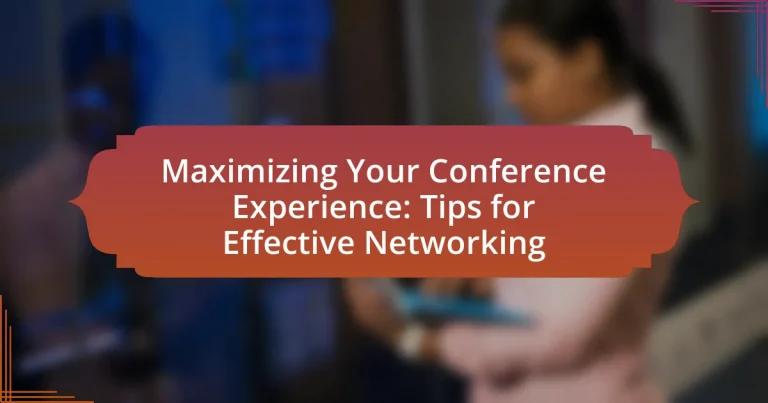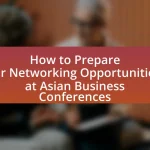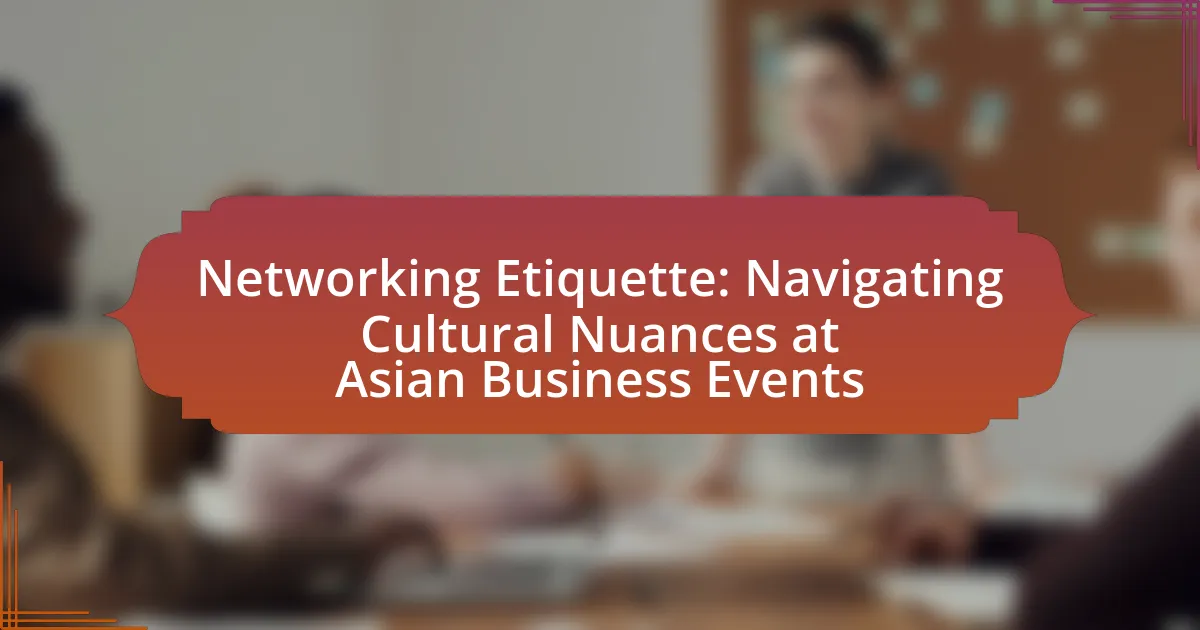Maximizing your conference experience involves actively engaging in activities that promote learning, networking, and personal growth. Key strategies include setting clear goals, preparing for networking opportunities, and understanding the distinction between networking and socializing. Effective networking enhances professional relationships and career prospects, with preparation and follow-up being crucial elements. The article outlines practical tips for initiating conversations, utilizing social media, and overcoming common challenges faced during networking, ultimately emphasizing the significant benefits of building connections at conferences.
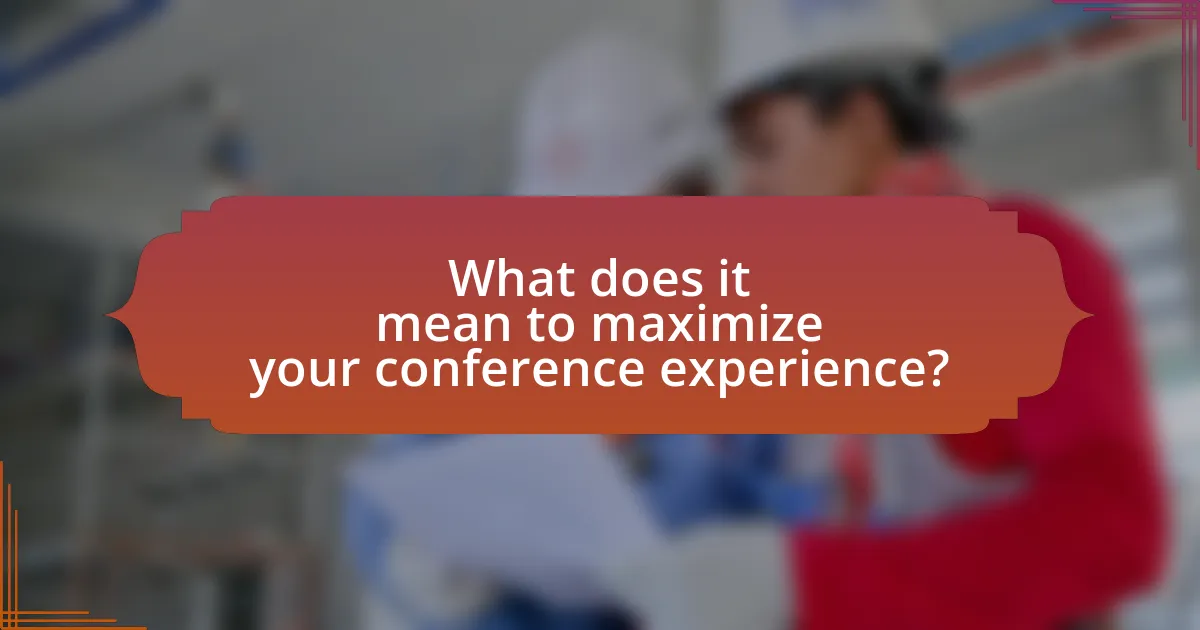
What does it mean to maximize your conference experience?
Maximizing your conference experience means actively engaging in activities that enhance learning, networking, and personal growth during the event. This involves setting clear goals for what you want to achieve, such as meeting specific individuals, attending key sessions, and participating in discussions. Research indicates that attendees who prepare in advance and actively seek out networking opportunities are more likely to form valuable connections and gain insights relevant to their professional development. For instance, a study by the Event Marketing Institute found that 84% of attendees believe networking is the most valuable aspect of conferences, highlighting the importance of strategic engagement.
How can effective networking enhance your conference experience?
Effective networking can significantly enhance your conference experience by facilitating valuable connections and opportunities for collaboration. Engaging with other attendees, speakers, and industry leaders allows for the exchange of ideas, insights, and resources that can lead to professional growth. Research indicates that 85% of jobs are filled through networking, highlighting its importance in career advancement. Additionally, networking can provide access to exclusive information and trends within your field, further enriching your knowledge and experience at the conference.
What are the key elements of effective networking at conferences?
The key elements of effective networking at conferences include preparation, active engagement, and follow-up. Preparation involves researching attendees and speakers to identify potential connections and setting clear networking goals. Active engagement requires initiating conversations, asking open-ended questions, and actively listening to others, which fosters meaningful interactions. Follow-up is crucial as it solidifies connections; sending personalized messages or connecting on professional platforms like LinkedIn can enhance relationships. These elements are supported by studies indicating that effective networking can lead to increased opportunities and collaborations, highlighting the importance of a strategic approach to networking at conferences.
How does networking differ from socializing at conferences?
Networking at conferences focuses on building professional relationships with the intent of creating opportunities for collaboration, mentorship, or business, while socializing is primarily about casual interactions and personal connections without a specific professional agenda. Networking involves strategic conversations aimed at exchanging information, discussing industry trends, and establishing contacts that can lead to future partnerships or job opportunities. In contrast, socializing is more about enjoying the event, making friends, and engaging in light-hearted discussions, which may not necessarily contribute to professional growth. This distinction is supported by research indicating that effective networking can lead to career advancement, as highlighted in studies showing that 70% of jobs are found through networking rather than traditional applications.
Why is preparation important for maximizing your conference experience?
Preparation is crucial for maximizing your conference experience because it enables attendees to engage effectively, network strategically, and gain valuable insights. By researching speakers, sessions, and attendees beforehand, participants can tailor their schedules to align with their goals, ensuring they attend the most relevant discussions. Studies show that well-prepared individuals are more likely to establish meaningful connections, as they can initiate informed conversations and ask pertinent questions, enhancing their networking opportunities. Additionally, preparation allows attendees to set clear objectives, which can lead to a more focused and productive experience overall.
What steps should you take before attending a conference?
Before attending a conference, you should research the event, prepare your networking strategy, and organize your materials. Researching the conference involves reviewing the agenda, speaker profiles, and attendee lists to identify key sessions and individuals relevant to your goals. Preparing a networking strategy includes setting specific objectives, such as the number of connections you aim to make or topics you want to discuss. Organizing materials entails gathering business cards, updating your resume, and preparing any necessary presentation materials. These steps enhance your ability to engage effectively and maximize your networking opportunities at the conference.
How can setting goals improve your networking outcomes?
Setting goals can significantly enhance networking outcomes by providing clear direction and focus during interactions. When individuals establish specific, measurable, achievable, relevant, and time-bound (SMART) goals, they are more likely to engage meaningfully with others, leading to stronger connections. Research indicates that goal-setting increases motivation and accountability, which can result in more productive networking experiences. For instance, a study published in the Journal of Applied Psychology found that individuals who set specific goals were 90% more likely to achieve desired outcomes compared to those who did not set goals. This demonstrates that goal-setting not only clarifies intentions but also drives effective networking strategies, ultimately leading to better professional relationships and opportunities.
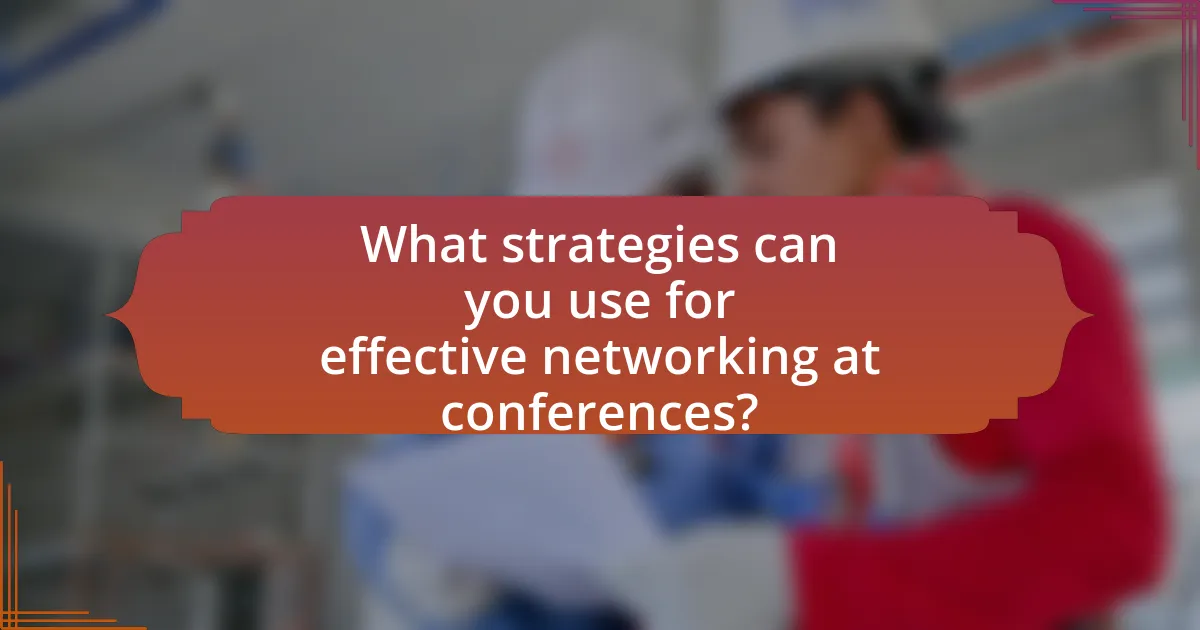
What strategies can you use for effective networking at conferences?
To network effectively at conferences, engage in proactive communication by initiating conversations with attendees and speakers. This can be achieved by preparing thoughtful questions related to the conference topics, which encourages dialogue and demonstrates genuine interest. Additionally, utilizing social media platforms, such as Twitter or LinkedIn, to connect with participants before, during, and after the event can enhance visibility and foster relationships. Research indicates that 85% of jobs are filled through networking, highlighting the importance of building connections in professional settings. Furthermore, attending workshops and breakout sessions allows for smaller group interactions, facilitating deeper connections with like-minded individuals.
How can you approach networking opportunities during the conference?
To approach networking opportunities during the conference, actively engage with attendees by initiating conversations and asking open-ended questions. This method fosters connections and encourages dialogue, making it easier to build relationships. Research indicates that effective networking can lead to career advancements, as 70% of jobs are found through networking, according to a study by the U.S. Bureau of Labor Statistics. Additionally, attending workshops and social events within the conference can provide structured environments for meeting new people, enhancing the likelihood of meaningful interactions.
What are the best ways to initiate conversations with other attendees?
The best ways to initiate conversations with other attendees include starting with a friendly greeting, asking open-ended questions, and finding common interests. Friendly greetings create a welcoming atmosphere, while open-ended questions encourage dialogue and engagement. For example, asking about the attendee’s experience at the conference or their thoughts on a recent session can lead to meaningful exchanges. Additionally, identifying shared interests, such as industry trends or mutual connections, can facilitate deeper conversations. Research shows that networking is most effective when individuals express genuine curiosity and actively listen, which fosters rapport and connection among attendees.
How can you effectively follow up after meeting someone at a conference?
To effectively follow up after meeting someone at a conference, send a personalized email within 24 to 48 hours of the meeting. This promptness demonstrates your interest and helps keep the connection fresh in both parties’ minds. In the email, reference specific topics discussed during your conversation to create a personal touch and reinforce the connection. According to a study by the Harvard Business Review, timely follow-ups significantly increase the likelihood of establishing a lasting professional relationship.
What role does body language play in networking?
Body language plays a crucial role in networking by conveying confidence, openness, and engagement. Effective body language, such as maintaining eye contact, offering a firm handshake, and using open gestures, helps establish trust and rapport with others. Research indicates that nonverbal communication accounts for approximately 93% of the emotional impact of a message, highlighting its significance in networking scenarios. For instance, a study by Albert Mehrabian emphasizes that body language can influence perceptions of credibility and likability, which are essential for successful networking interactions.
How can you use body language to create a positive impression?
To create a positive impression using body language, maintain open and confident posture, make appropriate eye contact, and use gestures that convey engagement. Open posture, such as uncrossed arms and legs, signals receptiveness and confidence, which fosters trust. Making eye contact demonstrates attentiveness and interest in the conversation, enhancing connection. Additionally, using purposeful gestures can emphasize points and show enthusiasm, making interactions more engaging. Research indicates that nonverbal communication accounts for a significant portion of interpersonal communication, with studies showing that body language can influence perceptions of competence and likability.
What non-verbal cues should you be aware of while networking?
Non-verbal cues to be aware of while networking include body language, eye contact, facial expressions, and personal space. Body language, such as open postures and gestures, conveys confidence and approachability, while closed postures may signal discomfort or disinterest. Eye contact is crucial; maintaining it shows engagement and sincerity, whereas avoiding eye contact can indicate insecurity or lack of interest. Facial expressions, like smiling, can create a welcoming atmosphere, while frowning or lack of expression may deter interaction. Additionally, respecting personal space is vital; standing too close can make others uncomfortable, while maintaining an appropriate distance fosters a more positive networking environment. These cues are supported by research indicating that non-verbal communication accounts for a significant portion of interpersonal interactions, with studies showing that up to 93% of communication effectiveness is derived from non-verbal signals.
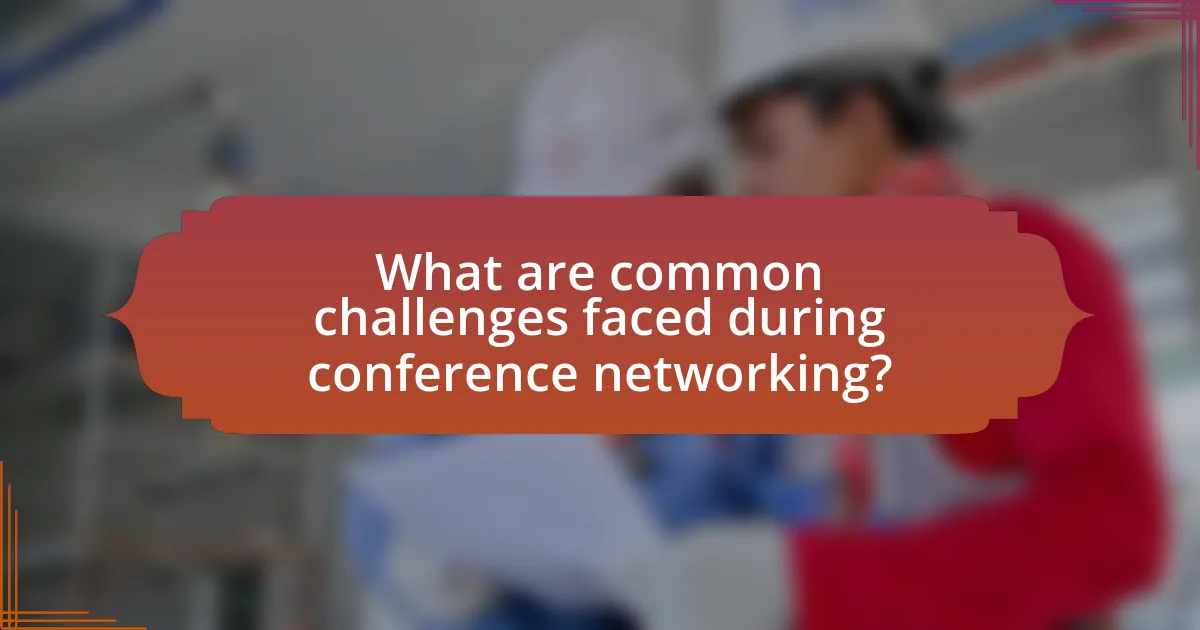
What are common challenges faced during conference networking?
Common challenges faced during conference networking include difficulty in initiating conversations, overcoming social anxiety, and managing time effectively. Many attendees struggle to approach strangers, which can hinder the formation of valuable connections. Social anxiety can exacerbate this issue, making it hard for individuals to engage in networking opportunities. Additionally, the packed schedules of conferences often leave little time for meaningful interactions, leading to missed opportunities for networking. According to a study by the Harvard Business Review, 70% of professionals find networking intimidating, highlighting the prevalence of these challenges in conference settings.
How can you overcome shyness or anxiety when networking?
To overcome shyness or anxiety when networking, individuals can prepare by practicing conversation starters and setting specific networking goals. Preparation helps build confidence, as studies show that familiarity with topics reduces anxiety levels. Engaging in role-playing scenarios or attending smaller networking events can also ease the transition into larger settings, as gradual exposure has been proven effective in reducing social anxiety. Additionally, focusing on the other person during conversations shifts attention away from self-doubt, which can further alleviate anxiety.
What techniques can help you feel more confident in networking situations?
To feel more confident in networking situations, practice active listening and prepare conversation starters. Active listening enhances engagement and shows genuine interest, which can ease anxiety. Research indicates that individuals who actively listen are perceived as more approachable and trustworthy, fostering better connections. Additionally, preparing conversation starters, such as questions about the event or shared interests, can alleviate the pressure of initiating dialogue. A study by the University of California found that having prepared topics significantly reduces social anxiety and increases confidence in networking scenarios.
How can you handle rejection or disinterest from others?
To handle rejection or disinterest from others, acknowledge your feelings and maintain a positive mindset. Recognizing that rejection is a common experience in networking helps to normalize the situation. Research indicates that resilience can be developed through practice, which allows individuals to bounce back from setbacks more effectively. For instance, a study published in the Journal of Personality and Social Psychology found that individuals who actively reframed negative experiences reported higher levels of emotional well-being. Therefore, focusing on the learning opportunities from each interaction can enhance future networking efforts.
What are the benefits of networking at conferences?
Networking at conferences provides significant benefits, including the opportunity to build professional relationships, gain industry insights, and enhance career prospects. By engaging with peers and industry leaders, individuals can exchange knowledge and ideas, which fosters collaboration and innovation. Research indicates that 85% of jobs are filled through networking, highlighting its critical role in career advancement. Additionally, conferences often feature workshops and panels that offer valuable information, allowing attendees to stay updated on trends and best practices in their field. This combination of relationship-building and knowledge acquisition makes networking at conferences a vital component of professional development.
How can networking lead to new opportunities and collaborations?
Networking can lead to new opportunities and collaborations by facilitating connections between individuals and organizations that share common interests or goals. When professionals engage in networking, they exchange information, resources, and ideas, which can result in partnerships, job offers, or collaborative projects. For instance, a study by the Harvard Business Review found that 70% of jobs are found through networking, highlighting its effectiveness in uncovering opportunities that may not be publicly advertised. Additionally, networking events often bring together diverse groups, fostering an environment where innovative collaborations can emerge, as individuals leverage each other’s strengths and expertise to achieve mutual objectives.
What long-term relationships can be built through conference networking?
Long-term relationships built through conference networking include professional collaborations, mentorship connections, and industry partnerships. These relationships often develop as individuals engage in meaningful conversations, share insights, and identify mutual interests during the conference. For instance, a study by the Harvard Business Review highlights that 70% of professionals attribute their career advancements to networking, indicating the potential for sustained relationships that can lead to collaborative projects or mentorship opportunities. Additionally, consistent follow-up after the conference can solidify these connections, transforming initial interactions into lasting professional bonds.
What practical tips can enhance your networking experience at conferences?
To enhance your networking experience at conferences, actively engage with attendees by initiating conversations and asking open-ended questions. This approach fosters meaningful interactions and helps build rapport. Research indicates that networking can lead to career advancements; for instance, a study by the Harvard Business Review found that 70% of jobs are filled through networking. Additionally, preparing an elevator pitch allows you to succinctly introduce yourself and your interests, making it easier for others to remember you. Utilizing social media platforms, such as LinkedIn, to connect with participants before and after the event can also strengthen these relationships.
How can you effectively use social media to connect with attendees?
To effectively use social media to connect with attendees, actively engage with them before, during, and after the event through targeted posts and interactions. This includes creating event-specific hashtags to facilitate conversations, sharing relevant content that encourages participation, and responding promptly to comments and messages to foster a sense of community. Research indicates that 79% of event attendees use social media to connect with other attendees, highlighting its importance in networking. By leveraging platforms like Twitter, LinkedIn, and Instagram, organizers can enhance attendee engagement and create lasting connections.
What are the best practices for exchanging contact information?
The best practices for exchanging contact information include being clear, concise, and respectful of privacy. When initiating the exchange, clearly state your intention and the value of connecting, which encourages the other person to share their information. Use business cards or digital tools like QR codes to facilitate easy sharing, ensuring that the method aligns with the context of the interaction. Additionally, always ask for permission before saving or using someone’s contact details, as this demonstrates respect for their privacy and builds trust. Research indicates that effective networking can lead to increased opportunities, with studies showing that 70% of jobs are found through networking, highlighting the importance of proper contact exchange practices.
